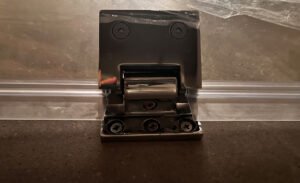The choice of hinge material is an important consideration that affects the operation and appearance of your bathroom when it comes to frameless shower door installations. Brass and stainless steel are the most widely used materials among the options available. Every material offers a unique combination of benefits. This post explores the advantages of each to help you choose the best metal for your frameless shower door hinges.
The Visual Impact of Brass and Stainless Steel
Brass Shower Door Hinges: Elegance and Warmth
For a long time, brass has been praised for its aesthetic value, especially in situations where the hardware can have a significant impact on the entire design. Brass hinges may improve the aesthetics of any bathroom because of its opulent lustre and range of finishes, including polished, antique, and brushed. This metal is versatile enough to go with any style, from modern to old, and it also gives a touch of classic elegance.
Stainless Steel Shower Door Hinges: Sleek and Modern
Stainless steel shower door hinges, on the other hand, provide a sleeker, more contemporary appearance. These hinges, which are well-known for having smooth, clean lines, blend in perfectly with modern bathroom designs. Stainless steel’s glossy, mirror-like surface may also reflect light exquisitely, making a shower area appear lighter and more spacious.
Durability and Maintenance: Longevity Matters
Brass: Durability with Easy Maintenance
The durability of brass is a major benefit, in addition to its attractive appearance. It is very resistant to wear and corrosion, which is crucial in a bathroom’s humid, water-exposed environment. Additionally simple to maintain, brass hinges only need to be cleaned with a little soap and water and occasionally polished to maintain their shine.
Stainless Steel: Robust and Low Maintenance
Stainless steel is well known for its durability and ability to withstand rust and tarnish. Because it can withstand frequent shower use without deteriorating, it is the ideal option for shower door hinges. The only real upkeep required for stainless steel hinges is frequently a quick wipe-down to get rid of any water stains.
Smooth Operation and Strength
Brass: Smooth and Effortless Functionality
Brass shower door hinges are particularly smooth in operation, allowing shower doors to open and close with ease. This makes taking a shower more comfortable and convenient because it is easy to use.
Strength and Stability: Brass vs. Stainless Steel
Both brass and stainless steel are robust materials, but because of their natural durability, brass provides more stability. It ensures long-term dependability without sacrificing the structural integrity of the shower door by providing good support for the weight of thick glass doors.
Versatility: Matching Your Decor
In addition to its practical advantages, brass hinges come in a variety of stylistic alternatives. Brass’s diversity in finishes guarantees that there is something for every taste, whether you’re looking for a hinge that makes a statement or one that complements the décor of your bathroom.
Conclusion: Making the Right Choice
Your unique requirements and tastes will determine whether you choose stainless steel or brass for your shower door hinges. Brass is a great option if aesthetics are important to you and you’re willing to keep them looking well. Stainless steel can be the best option for people who value toughness and little maintenance. In the end, both materials are excellent choices for frameless shower door installations since they each have unique advantages.



